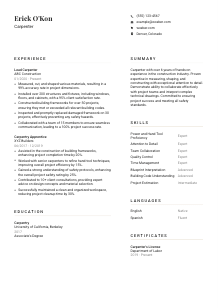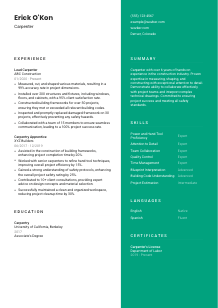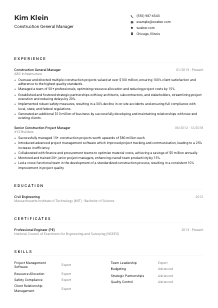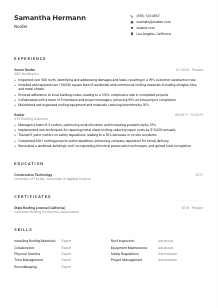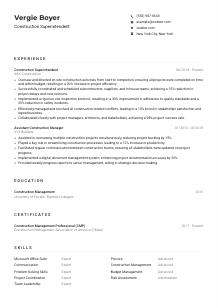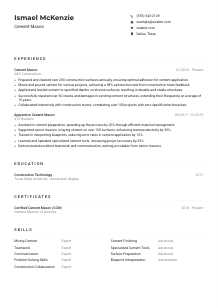Carpenter CV Example
Crafting wooden wonders, but your CV doesn't chisel it right? Sift through sawdust to this Carpenter CV example, built using Wozber free CV builder. Grasp how you can plane your carpentry expertise with job specifications, ensuring your career plank is as sturdy as your finest creations!
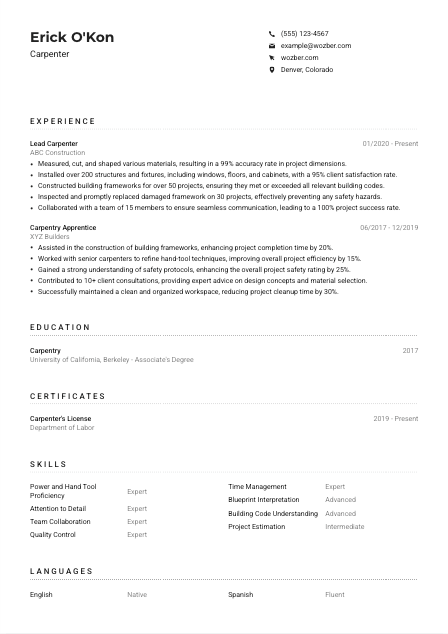
How to write a Carpenter CV?
Hello, aspiring Carpenter marvel! Ready to construct a CV that not only showcases your craftsmanship but also nails the job criteria square on the head? In the dynamic world of Carpentry, where precision and detail are paramount, your CV should reflect the same qualities. Utilizing the power of Wozber free CV builder, this guide will steer you through the intricacies of drafting an ATS-compliant CV tailored perfectly to your dream Carpenter position. Let's get started on building your professional blueprint!
Personal Details
The Personal Details section is your foundation. Just as the sturdiest homes start with a solid base, your CV begins here. Let's meticulously guide your hands in laying this first stone, aligning it with the Carpenter position to captivate your potential employer's interest from the first glance.
1. Carve Your Name
Envision your name as the bold header of your craftsmanship portfolio – it should be noticeable. Employ a clean, legible font that makes your name stand out, symbolizing the professionalism and pride you take in your work.
2. Align the Job Title
Just beneath your name, etch the position you're applying for - in this instance, "Carpenter." This direct approach ensures the hiring manager knows exactly what role you're targeting, showcasing your focused ambition.
3. Contact Information Must Be Flawless
Your contact details are like the handles of your tools – essential for connection. Ensure your phone number and email address are presented neatly. A professional email format is a must; something simple like firstname.lastname@email.com keeps it professional and accessible.
4. Location, Location, Location
The job's calling from Denver, Colorado, and if you're already there or willing to relocate, make it known right away. Mentioning your willingness to relocate or your current residency in Denver aligns with one of the key logistics the hiring manager is considering.
5. Online Portfolio: Show, Don't Just Tell
If you have an online portfolio or a LinkedIn profile showcasing your projects, include it. Your digital footprint can be a testament to your craftsmanship and attention to detail, key traits for a Carpenter.
Takeaway
A structured and precise Personal Details section lays the groundwork for your CV, inviting the hiring manager to delve deeper. Like the exact measurements for a perfect cut, ensure each detail here is tailored and clear. Ready your tools; you're setting the stage for a masterpiece.





Experience
The right Experience section can elevate your CV from a mere piece of paper to a testament of your carpentry journey. Let's chisel out your professional narrative, aligning each stroke with the responsibilities and achievements that mirror your tenure and expertise.
- Measured, cut, and shaped various materials, resulting in a 99% accuracy rate in project dimensions.
- Installed over 200 structures and fixtures, including windows, floors, and cabinets, with a 95% client satisfaction rate.
- Constructed building frameworks for over 50 projects, ensuring they met or exceeded all relevant building codes.
- Inspected and promptly replaced damaged framework on 30 projects, effectively preventing any safety hazards.
- Collaborated with a team of 15 members to ensure seamless communication, leading to a 100% project success rate.
- Assisted in the construction of building frameworks, enhancing project completion time by 20%.
- Worked with senior carpenters to refine hand‑tool techniques, improving overall project efficiency by 15%.
- Gained a strong understanding of safety protocols, enhancing the overall project safety rating by 25%.
- Contributed to 10+ client consultations, providing expert advice on design concepts and material selection.
- Successfully maintained a clean and organized workspace, reducing project cleanup time by 30%.
1. Break Down the Job Blueprint
Initiate with a keen eye, dissecting each requirement from the job listing. For instance, having a strong understanding of building codes and the proficiency in using power and hand tools are golden nuggets you'll want to mirror in your own story.
2. Construct Your Roles and Timelines
Structure your experience beginning with your most recent role, similar to how you'd tackle a building project – from the ground up. Ensure your job title, the company's name, and the duration of your role are clearly laid out, like planks in your career's framework.
3. Carve Out Achievements with Detail
Each bullet point under your roles is a chance to showcase your craftsmanship. Reflect tasks like "Measured, cut, and shaped various materials, resulting in a 99% accuracy rate in project dimensions" to directly tie your skills with the job's requirements.
4. The Power of Quantification
Numerical achievements can strengthen your CV like steel beams in construction. Whether it's the number of projects you've led, the percentage of customer satisfaction, or efficiency improvements, make these figures your allies.
5. Keep it Relevant and Riveting
Tailor your experiences to resonate with the Carpenter role, trimming away any unrelated details. Just as you wouldn't use a framing hammer for fine chiseling, discard any irrelevant experience that doesn't serve your goal.
Takeaway
With each step, you've been sculpting your professional narrative, demonstrating that you don't just meet the criteria - you exceed it. Visualize the hiring manager nodding in approval, recognizing the craftsman behind the CV. You're not just applying; you're showcasing a portfolio of achievements.
Education
While hands-on experience is vital in carpentry, your educational background lays the foundational knowledge. Let's ensure this section solidifies your qualifications, aligning perfectly with your craft.
1. Measure Twice, Cut Once
Identify the education requirements specified in the job posting. In this case, an Associate's Degree in Carpentry sets you apart as someone with both practical skills and theoretical understanding.
2. Construct Your Educational Timeline
Maintain clarity and brevity when listing your educational credentials. Outline your degree, the institution, and the year of graduation, much like laying out the blueprint for a project before the work begins.
3. Tailor Your Degree to Fit
If the job description highlights a specific educational background, like the Associate's Degree in Carpentry, ensure it's proudly displayed. It's like selecting the right wood type for a particular finish – it shows you know your stuff.
4. Sanding the Edges
For younger carpenters or those new to the field, relevant coursework, clubs, or extracurricular activities related to carpentry can embellish your section – like the fine finish on a piece of furniture.
5. Polishing with Additional Achievements
Graduating with honors, participating in carpentry competitions, or relevant projects can add a luster to your education section. However, ensure these highlights are pertinent and contribute to the narrative you're building.
Takeaway
Just as a solid foundation is critical for any structure, your educational background fortifies your CV. It assures employers of your commitment and capacity to learn, underpinning your practical experience with essential knowledge. Let it stand robust, supporting the arc of your professional journey.
Certificates
In carpentry, certifications are like the varnish that enhances and protects your work. They validate your skills and commitment to the profession. Let's strategically place these certificates in your CV, making them hard to overlook.
1. Select Your Best Tools
Revisit the job description to identify any certifications specifically requested, such as a Carpenter's License. These are your hand-selected tools, the ones that show you're fully equipped for the job.
2. Quality Over Quantity
Feature certifications that align directly with the job's demands. Placement of a valid Carpenter's License at the forefront of your CV is akin to displaying your finest piece of craftsmanship in your portfolio.
3. Freshness Matters
Certifications with a validity period should be up-to-date. Think of them as your sharp tools, ready at a moment's notice. Outdated certifications are like blunt chisels – they won't make the cut.
4. Continuous Growth
The carpentry field evolves, and your certifications should reflect a commitment to keeping pace. Like regularly oiling your tools to maintain their condition, seek out new certifications that bolster your expertise.
Takeaway
Strategically positioning your certifications in your CV serves as a testament to your professionalism and dedication to the craft. These aren't just accolades; they are proof of your continuous journey in mastering carpentry. Let them shine brightly, catching the eye of your future employer.
Skills
Your skills section is the toolbox of your CV, packed with the abilities and expertise you bring to the table. Let's organize this toolbox to highlight your most relevant carpentry skills, making it impossible for the hiring manager to pass over.
1. Inventory Your Skills
Start by laying out all your tools – in this case, your skills. Both hard skills, like "Power and Hand Tool Proficiency," and soft skills, such as "Team Collaboration," are crucial in the carpentry field.
2. Match to the Blueprint
From your inventory, select skills that directly align with the job description. Ensuring "Attention to Detail" and "Blueprint Interpretation" from our CV example are listed shows you're in tune with the job's needs.
3. Organize for Easy Access
Like a well-organized toolbox, your skills section should be neat and accessible. Focus on the skills that will most interest the hiring manager, ensuring they can quickly see your value as a Carpenter.
Takeaway
Carefully selecting and displaying your skills is like laying out your best tools for a job. Each skill you list is a testament to your craftsmanship and the unique attributes you bring to the table. Keep them honed, ready to impress at a moment's notice.
Languages
In a world that's constantly shrinking, the ability to communicate in multiple languages can set you apart, even in carpentry. Whether it's detailing a project to a client or coordinating with a diverse team, let's ensure your language prowess enhances your CV.
1. Understand the Linguistic Blueprint
Initially, review the job posting for any language requirements or preferences. For our Carpenter role, proficiency in English is essential, laying down the groundwork for our linguistic section.
2. Detail Essential Languages
If the job highlights a need for a specific language, like English in our example, prioritize it. Indicating "Native" proficiency underlines your ability to communicate effectively, an invaluable skill on any job site.
3. Showcase Additional Linguistic Skills
Beyond the required languages, listing others you're fluent in can enhance your profile, painting you as a versatile candidate. It's the equivalent of revealing a hidden skill, one that might tip the scales in your favor.
4. Honest Proficiency
Clearly define your level of proficiency using terms like "Native," "Fluent," "Intermediate," and "Basic." It's important that your employer has an accurate understanding of your linguistic capabilities, avoiding any miscommunication.
5. Match to the Job's Needs
Consider the broader scope of the role. If the job involves interaction with a diverse client base or team, your language skills can be a significant asset. Contextualize your linguistic abilities to the job's demands, showcasing them as a bridge to successful communication.
Takeaway
Your ability to communicate in multiple languages is a unique facet of your professional profile, potentially opening doors to opportunities within a global or multicultural context. Consider it another tool in your extensive toolbox, ready to be wielded when the situation arises. Keep speaking, keep connecting!
Summary
A compelling summary section is like the façade of a beautifully crafted piece of furniture – it invites closer inspection. Here's how to distill your carpentry career and skills into a few powerful lines, making a lasting impression on hiring managers.
1. Lay the Foundation
Begin by fundamentally understanding the job you're applying for. Absorb every requirement, every hint at what makes the ideal candidate. Your summary is your chance to reflect back at them not just what they want, but why you're the best fit.
2. Craft Your Introduction
Start your summary with a strong, concise statement about your professional standing. "Carpenter with over 6 years of hands-on experience," immediately anchors your CV in a solid foundation of expertise.
3. Align with Key Job Requirements
Echo the job's requirements with your pivotal achievements. Highlighting your "exceptional attention to detail" and "ability to interpret complex technical drawings" directly speaks to the core competencies sought by the employer.
4. Concision is Key
Your summary is a highlight reel, not the full story. Keep it punchy and impactful, focusing on the essence of your professional identity. This is your elevator pitch – make every word count.
Takeaway
Think of your summary as the initial handshake – firm, confident, and reflective of your character. This section not only introduces you but entices the reader to explore further, intrigued by the craftsmanship and expertise you bring to the table. Let it be the compelling opening to your professional narrative.
Launching Your Carpenter Journey
With your CV now finely crafted, from the personalized details to the summary that succinctly encapsulates your expertise, you're ready to step into the limelight. This isn't just a document; it's a testament to your skill, dedication, and the unique qualities you bring as a Carpenter. Wozber's free CV builder, with its ATS-friendly CV templates and ATS CV scanner, is here to ensure your CV is as finely tuned as your craft.
Let your CV be the bridge to your next great opportunity. Go forth, craft with confidence, and let your professional journey soar!

- Minimum of 5 years of experience in carpentry or related field.
- Proficient in the use of power and hand tools, including measuring, cutting, and shaping materials.
- Strong understanding of building codes and safety regulations.
- Exceptional attention to detail and ability to interpret blueprints and technical drawings.
- Possession of a valid Carpenter's License or certification, if applicable.
- Must be adept at English language communication.
- Must be located in or willing to relocate to Denver, Colorado.
- Measure, cut, and shape wood, plastic, fiberglass, and other materials.
- Install structures and fixtures, such as windows, floors, and cabinets.
- Construct building frameworks, including walls, floors, and doorframes.
- Inspect and replace damaged framework or other structures and fixtures.
- Collaborate and communicate effectively with clients, project managers, and team members to ensure project success.





